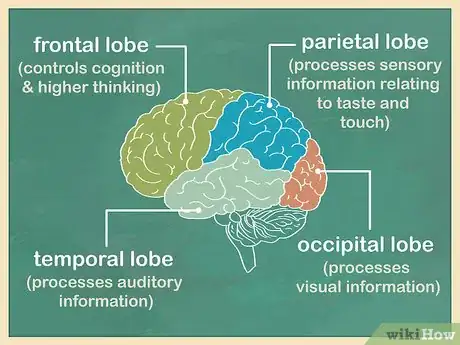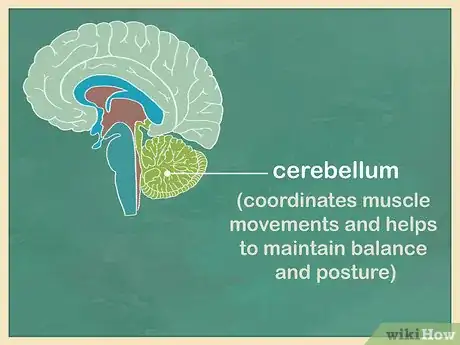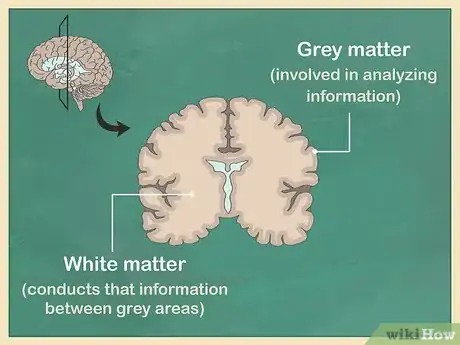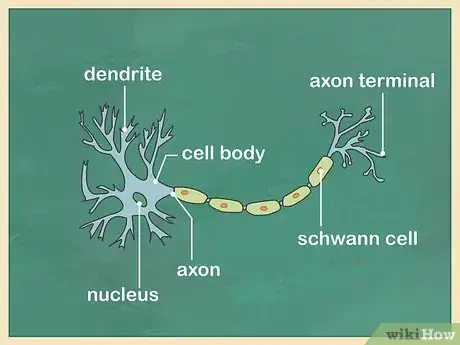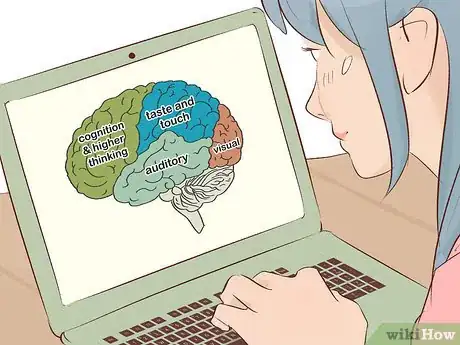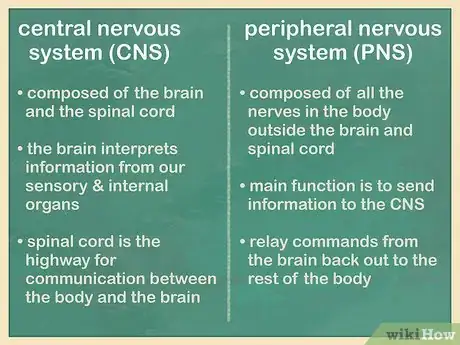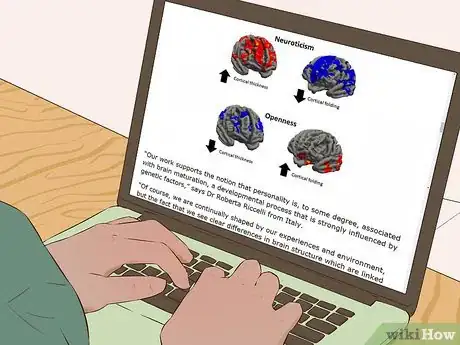This article was co-authored by wikiHow Staff. Our trained team of editors and researchers validate articles for accuracy and comprehensiveness. wikiHow's Content Management Team carefully monitors the work from our editorial staff to ensure that each article is backed by trusted research and meets our high quality standards.
There are 14 references cited in this article, which can be found at the bottom of the page.
This article has been viewed 20,534 times.
Learn more...
The brain is arguably the most important and the most complex organ in the human body. It’s responsible not only for the daily performance and regulation of automatic bodily functions, but also for our thoughts, feelings, and even our entire perception of reality. The biological structure and functioning of the brain are very complicated, and so studying the brain can understandably seem a very daunting task. However, by starting with the anatomy of the brain and moving on to the processes that make it work, you can begin to come to an understanding of the brain.
Steps
Breaking Down the Structure of the Brain
-
1Start with the cerebrum and the cerebral cortex. The cerebrum is the largest part of the human brain, making up 85% of its weight, and the cerebral cortex is its outermost layer. Because of both its size and its importance, the cerebrum should be the first part of the brain you study.[1]
- The cerebral cortex is responsible for all of your higher thought processes, such as speech and decision-making. Because of this, it’s arguably the single most important part of the human brain.[2]
- The cerebral cortex is made up of 4 lobes: the frontal lobe (which controls cognition and higher thinking), the parietal lobe (which processes sensory information relating to taste and touch), the temporal lobe (which processes auditory information), and the occipital lobe (which processes visual information.
- Note that the cerebrum is divided into 2 hemispheres, the left and the right. These hemispheres correspond to activity on the different sides of your body.
-
2Learn about the other structures of the cerebrum. Although the cerebral cortex gets most of the attention, there are other subcortical structures in the cerebrum that you’ll need to know about. Make sure to also study the hippocampus, the basal ganglia, and other structures beneath the cerebral cortex.
- The hypothalamus plays a key role in regulating those bodily functions that occur automatically, such as feeling hungry or sleepy, as well as regulating your body temperature and blood pressure.[3]
- The basal ganglia includes smaller structures that help to coordinate fine motor movements, like the movement of your fingertips.
- This part of the brain also includes the pituitary gland, the pineal gland, and the thalamus.[4]
Advertisement -
3Move on to the brainstem and its functions. The brainstem serves an important connecting role between your cerebrum and spinal cord. Additionally, it plays a critical role in controlling the heart, breathing, and consciousness.[5]
- The brainstem includes nerve fibers that carry signals between your brain and the rest of your body. In other words, it’s responsible for helping turn thoughts in your cerebral cortex into bodily actions.[6]
- The brainstem also supplies some of the cranial nerves to the face and head.
-
4Understand what the cerebellum does. The cerebellum (not to be confused with the cerebrum) plays a key role in your body’s movement. Specifically, it coordinates muscle movements and helps you maintain your balance and posture.[7]
- The cerebellum is one of the easier brain structures to remember the location of; it’s right at the base of the skull, where your skull and the top of your neck meet.
- Some research has indicated that the cerebellum may also play a role in emotional sensitivity, although there’s no consensus among neuroscientists on this point.[8]
-
5Familiarize yourself with grey and white matter. Your brain isn’t composed of one single type of tissue; instead, there are two principal tissues at work in the brain: grey matter and white matter. Learn the different ways these two tissue types function to round out your knowledge of the brain’s anatomy.
- Grey matter is primarily involved in analyzing information, whereas white matter conducts that information between grey areas.[9]
- A key difference between grey and white matter is that grey matter contains far more cell bodies than white matter does.
- The ratio of grey matter to white matter in the brain continually fluctuates as humans age.
Learning About Neurological Processes
-
1Study how neurons function. Neurons are the main type of cell at work in brain functioning. As such, they’re the building block to all neurological processes. Make sure you have a working knowledge of how these cells are structured and how they work inside the brain.
- Neurons work by sending out electrical signals via a rapid change in voltage called an “action potential.”[10]
- Neurons are composed of three main parts: the cell body, the axon, and dendrites. The cell body transmits electrical signals down the axon to the dendrites, where it travels to the dendrites of an adjacent neuron.[11]
-
2Get to know how the brain processes information. One of the key functions of the brain is to make sense of all the information our eyes, ears, and other sensory organs take in. Study the different pathways sensory input travels into the brain and how the brain turns that into knowledge.
- For example, visual and auditory stimuli travel directly into the brain through the occipital and temporal lobes, respectively. Meanwhile, most other forms of information enter the brain through the spinal cord.[12]
- Each hemisphere of your cerebral cortex is responsible for processing half of the sensory input your brain receives. In most cases, the left hemisphere processes information from the right side of the body, and the right hemisphere processes information from the left side of the body.
-
3Learn the difference between the central and peripheral nervous systems. Your nervous system actually has two components, the central nervous system (CNS) and the peripheral nervous system (PNS). Study the distinctions between these two components to get a better sense of how the brain interacts with the body.
- The central nervous system is composed of the brain and the spinal cord. These two together serve as the nervous system’s “command center.”[13]
- The peripheral nervous system is made up of all the nerves in the body outside the brain and spinal cord. The PNS’s main function is to send information to the CNS and then relay commands from the brain back out to the rest of the body.
-
4Understand what causes mental disorders. Studying the brain not only involves knowing how it works, but also knowing how it can go wrong. Familiarize yourself with how brain defects can lead to mental disorders to better understand the relationship between the brain and the mind.
- For example, many scientists argue that mental illnesses are the result of communication errors between neurons in the brain. Such conclusions have led to the development of medications that manipulate how neurons function in order to treat mental illness.[14]
- Studying the brain-based causes of mental disorders will not only give you a better sense of how different parts of the brain work in tandem with one another but may also inspire you to pursue research in this area of neuroscience.
-
5Consider how personality is influenced by the brain. When studying the brain, you’re not only studying a physical organ’s structure and functionality, but you’re also delving into the physical basis of our mental selves. Study up on research into how the brain shapes personality to get a better sense of how the brain is connected to who we are as individuals.
- For example, researchers have found that there is a significant connection between the thickness of the cerebral cortex and high levels of neuroticism, which can lead people to develop neuropsychiatric disorders.[15]
- Questions about the brain’s impact on personality will also encourage you to think more about the question of nature versus nurture and may even lead you to change your mind about what you believe impacts people the most!
Taking Classes on the Brain
-
1Register for a college course on brain science. If you’re in college or about to attend college, you may want to take the opportunity to learn about the brain in a classroom setting. Sign up for a brain science course to study the brain in detail and with the help of an instructor.
- Examples of some courses you can take on the brain include behavioral neuroscience, cognitive neuroscience, and neurobiology.[16]
- If you enjoy the course you sign up, look into making neuroscience your major to focus your education more specifically on the brain.
-
2Consider applying to medical school. If you want to make a professional career out of studying the brain, becoming a neurosurgeon or neuroscientist are options you should consider. Look into applying to study the brain in medical school, to be on the cutting edge of brain research.
- Medical students study the brain through lectures, where information is presented and memorized, as well as in labs, where students study the physical properties of the brain.[17]
- Note that studying the brain at this level, like many other biological sciences, requires a great deal of memorization in order to be successful.
-
3Attend a free online course on the brain. If you’re not in college or are only casually interested in the brain, enroll in a free online course to study neuroscience without the cost or stress of higher education.
- Use the Open Education Consortium to find online university classes that are offered for free to the general public. These will allow you to study the brain at a college level but on a casual basis.[18]
References
- ↑ https://www.livescience.com/29365-human-brain.html
- ↑ http://brainmadesimple.com/cortex-and-lobes-of-the-brain.html
- ↑ https://www.mayfieldclinic.com/PE-AnatBrain.htm
- ↑ https://www.mayfieldclinic.com/PE-AnatBrain.htm
- ↑ https://www.livescience.com/29365-human-brain.html
- ↑ https://bouve.northeastern.edu/nutraumaticbraininjury/braintbi-anatomy/brain-functions/
- ↑ https://www.mayfieldclinic.com/PE-AnatBrain.htm
- ↑ https://courses.lumenlearning.com/boundless-psychology/chapter/structure-and-function-of-the-brain/
- ↑ https://bouve.northeastern.edu/nutraumaticbraininjury/braintbi-anatomy/brain-functions/
- ↑ https://www.moleculardevices.com/applications/patch-clamp-electrophysiology/what-action-potential
- ↑ http://whoami.sciencemuseum.org.uk/whoami/findoutmore/yourbrain/howdoesyourbrainwork/howdoesyournervoussystemwork/whichnervecellsdowhat
- ↑ http://www.tbiguide.com/howbrainworks.html
- ↑ http://www.gwinnett.k12.ga.us/LilburnES/PromoteGA/biochemistry/Brain_CNS.html
- ↑ https://www.ncbi.nlm.nih.gov/books/NBK20369/
- ↑ http://www.cam.ac.uk/research/news/personality-traits-linked-to-differences-in-brain-structure
- ↑ https://bigfuture.collegeboard.org/majors/biological-biomedical-sciences-neuroscience
- ↑ http://www.med.tum.de/de/biomedicalneuroscience
- ↑ http://www.oeconsortium.org/about-oec/
